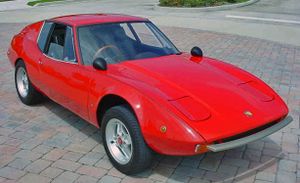O.T.A.S.
O.T.A.S. (Officina Transformazione Automobili Sportive) was yet another Italian outfit that built Fiat-based sports cars. The primary character in the O.T.A.S. story is Francis Lombardi. Lombardi headed his own carrozzeria in Vercelli, Italy, producing small runs of custom-bodied automobiles. His background and education was in aeronautics, though Lombardi did not produce automobiles that appeared to be specifically aircraft inspired.
In about 1967, Lombardi elected to produce a sports car based on then-new Fiat 850 mechanicals package - certainly a big step up from the 500- and 600-based drivetrains these specialty manufactures had been toiling with for the previous decade. How, and by whom, Lombardi's diminutive sports coupe was styled is a bit of a mystery, but the best guess is that is was a joint effort of Lombardi and other locals who may or may not have worked for him.
One story holds that it was inspired by an Autobianchi-based Fiat prototype for what eventually became the X1/9. Whatever, it's tidy design, well proportioned, and one that curiously foreshadowed several exotics that would soon follow: You can see Pantera in the front clip, BMW M1 in the rear deck area, and pre-shrunk Maserati Indy everywhere. Another styling analogy? Take a look at either the early or the late Saab Sonnett, and the Grand Prix falls somewhere in between. The car debuted as the Lombardi Grand Prix in 1968. The design accomplisch one thing, however, and that is to seem relatively free of scale: Unless something or someone is around the car, it looks as it if may be as large as the aforementioned M1 or Pantera.
Credit Lombardi for investing in the tooling to build the Grand Prix to "real" production standards: Instead of the more common, and more cost-effective, alloy or fiberglass coachwork, the Grand Prix was steel-bodied,save for a few small panels which were rendered in fiberglass. The balance of the chassis and running gear was essentially stock Fiat 850, though Lombardi and others built all manner of uprated engines for them. The engine was mounted out back, as was the fully synchronized four-speed manual transaxle.
The suspension design is a bit unusual with upper A-arms and a lower tranverse leaf spring up front and semi-trailing arms and coil springs out back. Front and rear sway bars did their best to control the potentially unusual handling habits of the odd componentry. Steering was via worm-and-gear, and brakes were discs up front with drums in back.
This car is small. Not quite in the micro car sense of the term, but diminutive to be certain. With an overall length of 142 in., it would fit meatly between the wheel centers of most extended-cab pickup trucks. The Grand Prix's 81-in. wheelbase is 9-in. less than a Miata's. You would figure a bit short on room for something like, oh say, occupants, but the interior is quite adequate for two. A full complement of instruments are set in a binnacle at the middle of the dash, with the interior finished in a simple-but-sporty black carpet/black vinyl combo.
It only made sense that someone would want to import these cars to the U.S., and that someone was John Rich. Rich owned a Fiat dealership and a body shop in Glendale, Calif., and was originally drawn by the car's styling. He was also the U.S. Abarth importer, so esoteric Fiats were parts of his existence. Shortly after the Grand Prix's introduction, Lombardi and Franco Giannini, whose works did much of the mechanical assembly of the caras, formed O.T.A.S. in order to develop versions of the car for markets outside of Europe.
Recall that by 1970, emissions and safety laws were already impacting the way cars were built, or could be imported. But Rich had a plan. In summary, cars that were of limited production and/or powered by engines of less than 50 cu. in., were exempted from most of the red tape. The 1000cc versions of the Grand Prix were out of the question, but by de-stroking the 850 engine down to 817 cc, Rich had his 50-cube motor. The Lombardi Grand Prix-based OTAS 820 was born, and on its way to our shores.
It seems most of the cars were imported and sold here between 1968 and late 1971. Rich licensed a few dealers througout the country, but as far as how many 820's made it here, it's anyone's guess.Source
External Links
| Car Information and Photos by Marque: A - B - C - D - E - F - G - H - I - J - K - L - M - N - O - P - Q - R - S - T - U - V - W - X - Y - Z |
| Motorcycle Information and Photos by Marque: A - B - C - D - E - F - G - H - I - J - K - L - M - N - O - P - Q - R - S - T - U - V - W - X - Y - Z |





